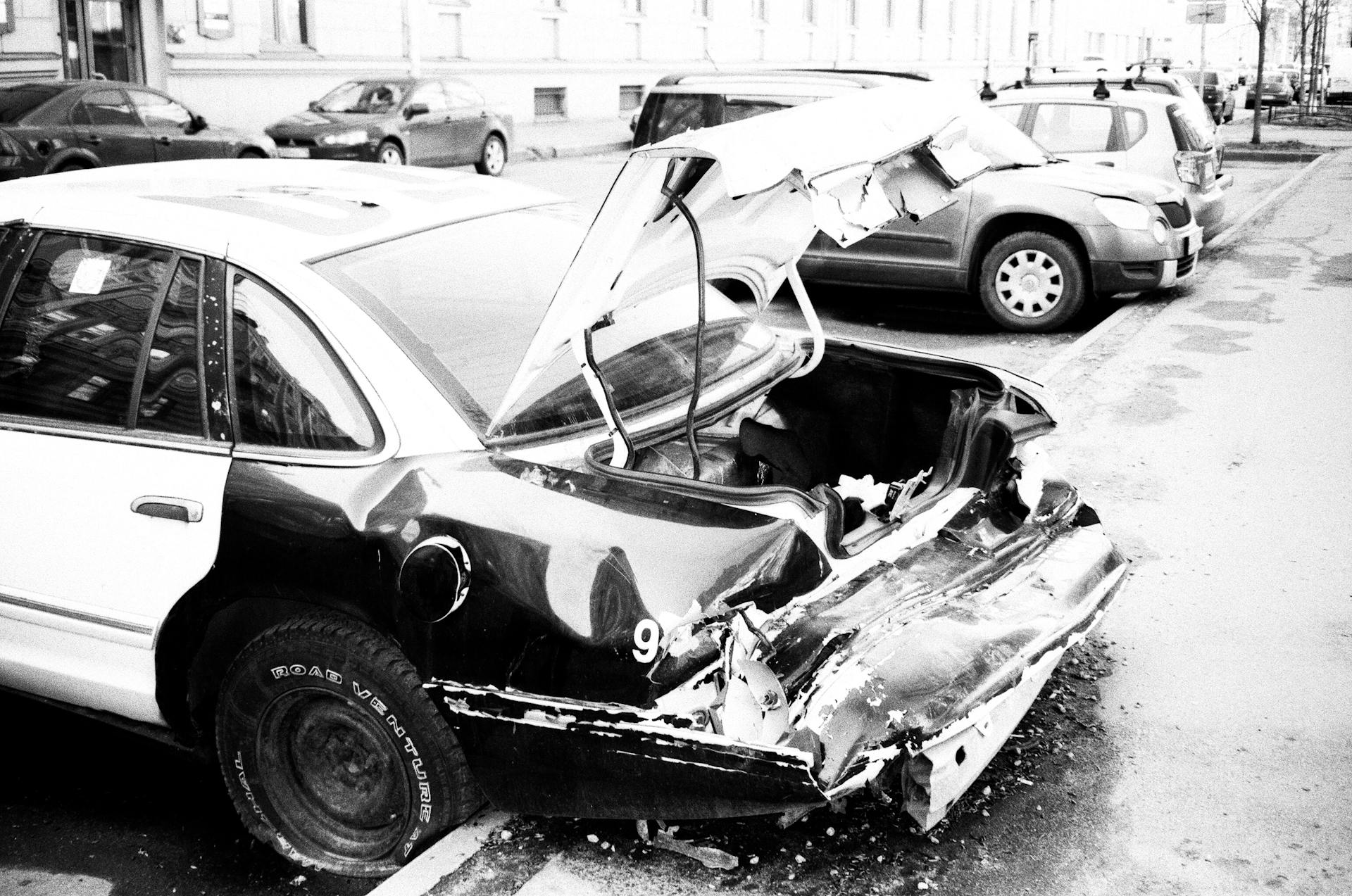
Pollution liability coverage extension endorsement is a type of insurance that protects businesses from costly lawsuits and fines related to environmental pollution.
This endorsement typically extends the coverage of a standard liability policy to include pollution-related claims, such as those resulting from contaminated soil or groundwater.
Pollution liability coverage can be purchased as a standalone policy or as an endorsement to an existing liability policy.
Environmental insurance, including pollution liability coverage, can help businesses avoid financial ruin in the event of a pollution-related incident.
Expand your knowledge: Environmental Liability Coverage
Why Small Businesses Need Environmental Insurance
Small businesses need environmental insurance because environmental hazards can arise from many sources and can affect businesses in almost any line of work.
Under both federal and state laws, any business, organization, or individual could be held legally responsible for any pollution damage if they cause a pollution incident that damages properties, individuals, and the environment itself.
Environmental liability insurance provides businesses with liability coverage for environmental risks from pollution exposures, as well as any pollution legal liability and cleanup costs they might face.
Related reading: Contractors Pollution Liability Coverage
If a business is found responsible for a pollution incident, they might have to hire environmental consultants and pay for expensive remediation.
Their staff, neighbors, or customers could suffer medical issues or file a lawsuit, resulting in costly legal fees.
Environmental liability insurance can help mitigate these costs and protect a business's assets.
Environmental Insurance Coverage and Exclusions
Environmental insurance coverage and exclusions can be complex and confusing. Some property insurance policies contain a broad form pollution exclusion, which may have a token sublimit for pollution cleanup of covered property.
Pollution exclusions can be found in both liability and property insurance policies, and they often contain an anti-concurrent causation clause that eliminates proximate cause of loss arguments. This means that if a claim arises from a pollution-related event, coverage may be denied even if the event was caused by a separate, non-pollution-related factor.
In some cases, exclusions for specified pollutants, such as mold or asbestos, may be included in insurance policies. These exclusions can be referred to as "total pollution" exclusions. It's essential to review the policy and endorsements carefully to understand the specific exclusions and limitations.
Here is a summary of common exclusions in property and liability insurance policies:
It's crucial to understand the specific exclusions and limitations in your insurance policy to ensure you have adequate coverage for environmental risks.
What Does Environmental Liability Insurance Cover?
Environmental liability insurance covers damage resulting from an environmental mishap, including lead paint and water lines, mold, Legionnaires' disease, noxious odors, viral and biological risks, oil and chemical spills, air and water pollution, and brownfields and toxic disposal sites.
This type of insurance can be added as an endorsement to your general liability insurance for an added cost, as it is typically not included with this policy. Many general liability policies have an "absolute pollution exclusion" that denies coverage for most pollution and environment-based events.
Environmental liability insurance protects businesses against the costs of client lawsuits over unsatisfactory work related to environmental risks, as well as any pollution legal liability and cleanup costs they might face.
Take a look at this: Homeowners Insurance Cover Water Damage
Examples of exceptions to the pollution exclusion include:
- CG 04 22–Pollution Liability Coverage Extension
- Specific operating fluids released by contractors at job sites
- Pollution from materials required to be brought into a building
- Lawn Care Services–Limited Pollution Coverage
These exceptions cover bodily injury or property damage caused by specific types of pollution, such as gases, fumes, or vapors released from materials brought into a building.
In addition to these exceptions, some policies may have a token sublimit for pollution cleanup of covered property if the pollution was a result of an otherwise covered cause of loss.
There are also five optional CGL endorsements that provide "buy-back" coverage for parts of the pollution exclusion, including:
- CG 04 28–Pollution Exclusion–Named Peril Limited Exception for a Short-Term Pollution Event
- CG 04 29–Pollution Exclusion–Limited Exception for a Short-Term Pollution Event
- CG 04 30–Pollution Exclusion–Limited Exception for Designated Pollutant(s)
These endorsements provide coverage for pollution caused by or resulting from specific causes of loss, or for releases of specific pollutants.
Exclusion Endorsements
Exclusion endorsements are often used to specify excluded causes of loss in general liability policies. They can be used to exclude specific sources of contaminants like asbestos, silica, and lead.
These endorsements are essentially "total pollution" exclusions, and they can eliminate proximate cause of loss arguments. This means that even if a claim is related to a specific cause of loss, it may still be excluded if it's also related to a pollution exclusion.
In some cases, a claim may be excluded under both a pollution exclusion and a new generation specified contaminant exclusion.
Additional reading: Cyber Insurance War Exclusion
What Is Excluded
Environmental insurance coverage has its limitations, and it's essential to understand what's excluded. Insurance does not apply to pollution at or from any premises, site, or location now or ever owned, occupied by, or rented or loaned to any insured.
Coverage does not apply at or from any location or site used to handle, store, dispose of, process, or treat waste. This includes activities like transporting, handling, storing, treating, disposing of, or processing waste, which are excluded if the insured or someone they're responsible for was involved.
There's no coverage for pollutants brought to a location or site as part of operations performed by the insured or their contractors and subcontractors. This also applies to operations involving pollutant testing, monitoring, cleaning up, removing, containing, treating, detoxification, neutralization, response, or assessment.
The following are excluded from coverage:
- Pollution at or from any premises, site, or location now or ever owned, occupied by, or rented or loaned to any insured.
- Activities involving the handling, storage, disposal, processing, or treatment of waste.
- Operations involving pollutant testing, monitoring, cleaning up, removing, containing, treating, detoxification, neutralization, response, or assessment.
- Claims or suits by or on behalf of a governmental authority for damages due to testing for, monitoring, cleaning up, removing, containing, treating, detoxifying, neutralizing, responding to, or assessing the effects of pollutants.
Some states have solid case law establishing that bacteria is an excluded "pollutant" within the context of pollution exclusions. These states include California, Minnesota, Wisconsin, and Indiana.
Business Interruption
Business interruption can be a significant concern for businesses, especially those in industries with high environmental risks.
Pollution liability insurance often includes business interruption coverage, which can protect your business if it's forced to close temporarily due to an environmental accident.
This coverage may depend on your industry risks and location, so it's essential to check with an agent when you buy a policy to know what's included.
Worth a look: Business Interruption Insurance Nz
Defining a Pollutant
Defining a Pollutant can be a bit tricky, but let's break it down. A pollutant is defined on a policy, and it's essential to review this definition to see if the main pollution exposures of the insured would be covered if the loss did qualify as sudden and accidental.
The Insurance Services Office, Inc. (ISO) pollution exclusion can apply to bacteria contaminates, but this depends on the state's precedence case law. Currently, California, Minnesota, Wisconsin, and Indiana have solid case law establishing that bacteria is an excluded "pollutant" within the context of pollution exclusions.
See what others are reading: S Buys a 50000 Whole Life Policy
In some cases, insurance companies may deny a bacteria-related loss and be willing to go to court to let a judge figure out if bacteria is a "pollutant" or not. This can lead to a double jeopardy effect, where the potentially responsible parties associated with creating the bacteria release may not have any insurance coverage at all.
Here's an interesting read: With Disability Income Insurance an Insurance Company May Limit
Pollution Liability Coverage Extension Endorsement
Pollution Liability Coverage Extension Endorsements are available to address the coverage gaps associated with sudden and accidental pollution coverage. These endorsements can provide coverage for Bodily Injury, Property Damage, and Clean-up Costs.
There are five optional CGL endorsements that provide "buy-back" coverage for parts of the pollution exclusion, each requiring an additional premium charge. These endorsements include: CG 04 28, CG 04 29, CG 04 30, and two others that provide limited exceptions for short-term pollution events or designated pollutants.
The CG 04 30 endorsement, for example, provides coverage for bodily injury or property damage that arises out of any release of the pollutants listed on the endorsement schedule while used in conjunction with the insured's operations. This endorsement buys back some pollution coverage by amending the exclusion, but still excludes any pollution that results from storage tanks or containers, including ducts and piping below or partially below ground.
Related reading: Insurance Back Office Services
Core Aspects of Sudden and Accidental Endorsements
Sudden and accidental pollution endorsements often provide coverage for Bodily Injury, Property Damage, and Clean-up Costs.
The definition of a pollutant on the policy should be reviewed to ensure it covers the insured's main pollution exposures.
A key aspect to review is whether the loss would qualify as sudden and accidental.
The form should be checked to see if it provides coverage for these areas, as some may not.
Reviewing the policy definition of a pollutant is crucial to ensure coverage for the insured's main pollution exposures.
Sudden and accidental pollution endorsements often have a defined difference between sudden and accidental pollution compared to gradual pollution.
This difference can create a grey area, which can be addressed with alternative coverage solutions.
These solutions, such as Contractors Pollution Liability coverage, take out the grey area and provide broader coverage terms and conditions.
If this caught your attention, see: What Are Endorsements on Insurance Policies
This Policy Protects Against Claims
This policy protects against claims related to various environmental hazards. Lead paint and water lines are just a few examples of the types of pollution that can be covered.
Mold, Legionnaires' disease, and noxious odors are also included in this type of coverage. Viral and biological risks, oil and chemical spills, air and water pollution, brownfields, and toxic disposal sites are all part of the policy as well.
Here are some examples of what's covered:
- Lead paint and water lines
- Mold
- Legionnaires’ disease
- Noxious odors
- Viral and biological risks
- Oil and chemical spills
- Air and water pollution
- Brownfields and toxic disposal sites
This coverage can often be added as an endorsement to your general liability insurance for an added cost.
Environmental Insurance Costs and Risks
Environmental insurance costs can vary depending on several factors, with the average price for Insureon customers being $223 per month or $2,675 per year.
The cost of environmental insurance coverage depends on industry risks, location, number of employees, and annual payroll, which can significantly impact the overall cost.
If you're a business owner, it's essential to consider these factors when determining the cost of environmental insurance.
The cost of environmental insurance can add up quickly, but it's a crucial investment to protect your business from environmental risks and liabilities.
Worth a look: How Much Is Car Insurance in Ireland per Month
Here are some key factors that can affect the cost of environmental insurance:
Industry-Specific Environmental Insurance
Environmental insurance is crucial for various industries, but it's especially important for manufacturing businesses that use hazardous chemicals in their processes.
Manufacturing businesses that use hazardous chemicals in their products may face risks of damaging leaks, which can harm the surrounding environment.
Pollution liability insurance can protect these businesses from liability over damaging leaks, including lawsuits and cleanup costs.
For example, a metal manufacturer that uses hazardous chemicals to treat their products may need environmental insurance to cover the costs of a storage tank leak into a nearby ravine.
Businesses that distribute or transport manufactured goods, such as hazardous materials, may also need pollution coverage to protect themselves from inherent risks.
Environmental insurance can help pay for lawsuits and cleanup costs resulting from environmental mishaps, including damage to nearby areas.
A fresh viewpoint: How Does Insurance Protect a Policyholder against Financial Loss
Court Cases and Exclusions
In some cases, pollution-related court cases can be a challenge for businesses. Absolute pollution exclusions can be held applicable to allergic reactions to paint and glue fumes.
Pollution exclusions can be tricky to navigate. An absolute pollution exclusion was held inapplicable to a death caused by pesticides.
Businesses should be aware of the effective dates of their CGL policy. A CGL policy's effective dates can bar a board's claim for coverage of clean-up.
Defunct companies can face damages from cities seeking to hold them accountable. A city sought damages from a defunct company's former insurers.
CGL policies can exclude claims for pollution loss. A city's CGL policy excluded a claim for pollution loss.
Cleanup costs can be a significant expense for businesses. Cleanup costs were held not within the meaning of damages.
Contamination from manufacturing processes can have serious consequences. Contamination from a manufacturing process was not covered.
Businesses should be aware of the definition of "contaminant." "Contaminant" was clarified with respect to application.
Insurance companies can be held liable for pollution-related claims. Insurers faced a mixed obligation for an insured's pollution suit.
A "known" loss exclusion can be complex. A "known" loss exclusion was held not applicable.
On a similar theme: Proof of Loss Form for Insurance Claim
Landfill owners can face significant expenses for cleanup costs. Landfill owners sought coverage for cleanup costs.
Landlords can assert claims against tenants for contamination. A landlord asserted that a tenant's contamination constituted trespass.
Businesses should be aware of lead exclusions. Lead exclusions were held applicable to lead paint.
Pollution claims can arise from a variety of sources. Pollution claims arose from emissions from defective furnaces.
Businesses should be aware of the applicability of pollution exclusions. Pollution exclusions were held applicable to cigarette smoke.
Businesses should be aware of the definition of "sudden and accidental." Pollution exclusions were held applicable despite a "sudden and accidental" release of toxins.
Personal injury claims can be exempt from pollution exclusions. Pollution exclusions were not applicable to personal injury claims.
Businesses should be aware of the importance of clearly identifying pollutants. The use of gas in business operations and the failure to clearly identify gas as a pollutant obligated an insurer to handle a fuel spill claim.
Businesses should be aware of the coverage for voluntary environmental cleanup expenses. Voluntary environmental cleanup expenses were covered.
Worth a look: Florida Required Insurance Bodily Injury Property Damage
Introduction and Overview
The language in pollution exclusion policies has been a topic of controversy since its introduction in 1973. Court interpretations have varied widely over time, eroding the original intent of the exclusion.
The ISO Commercial General Liability Coverage Forms have been modified to clarify the exclusion of most types of pollution, regardless of whether the event is gradual or sudden. This change aimed to provide consistency in policy language.
Important exceptions have been added to the coverage form to provide common sense relief to policyholders. These exceptions help mitigate the impact of the exclusion.
Several endorsements have been created to provide coverage for exposures that the basic coverage form excludes, and some eliminate exceptions within the coverage form.
Take a look at this: Most Liability Policies Do Not Provide Coverage for
Frequently Asked Questions
What is the sudden and accidental pollution endorsement?
Sudden & Accidental coverage provides protection for unexpected pollution-related bodily injury and property damage, but only if reported promptly
Sources
- https://www.insureon.com/small-business-insurance/environmental-insurance
- https://b-h-a.com/blog/understanding-sudden-and-accidental-pollution-insurance-for-contracting-risks/
- https://berkleyenvironmental.com/coverages/environmental-combined-policy
- https://roughnotes.com/the-danger-in-the-neighborhood/
- https://www.irmi.com/articles/expert-commentary/a-users-guide-to-pollution-exclusions-and-environmental-insurance
Featured Images: pexels.com


